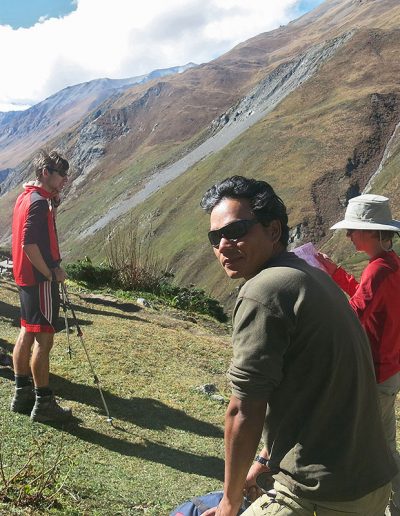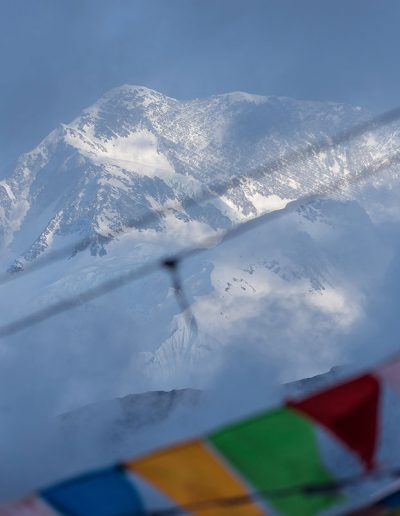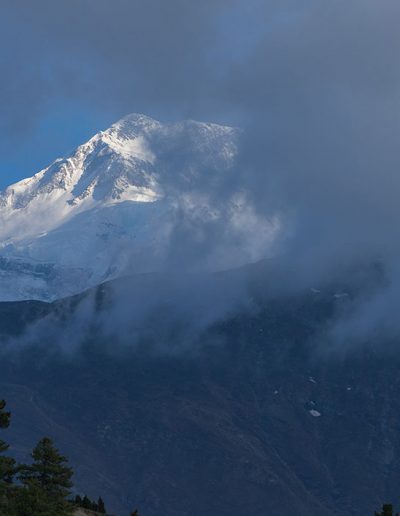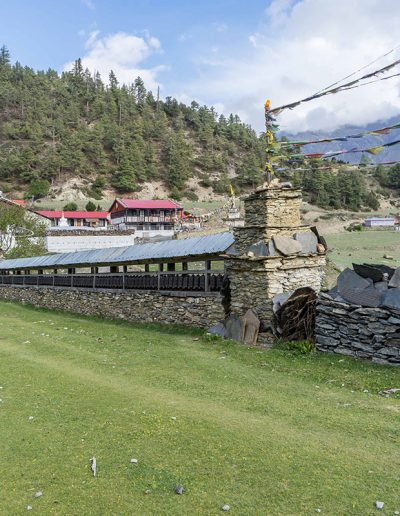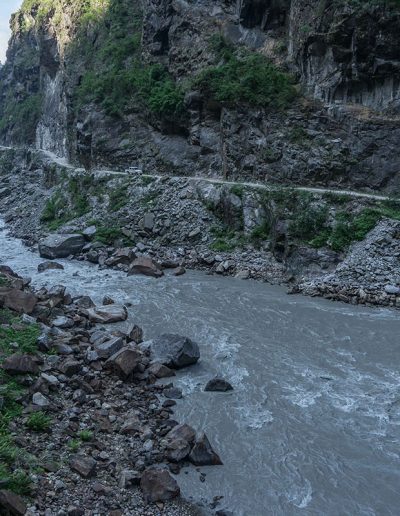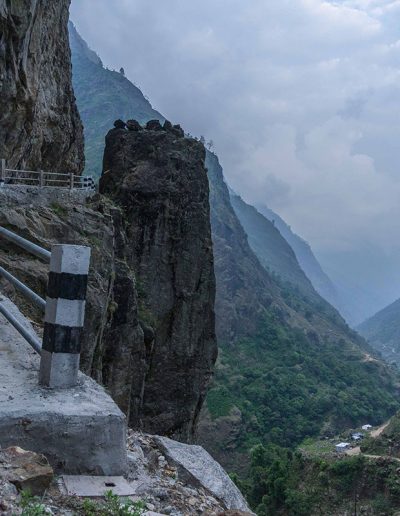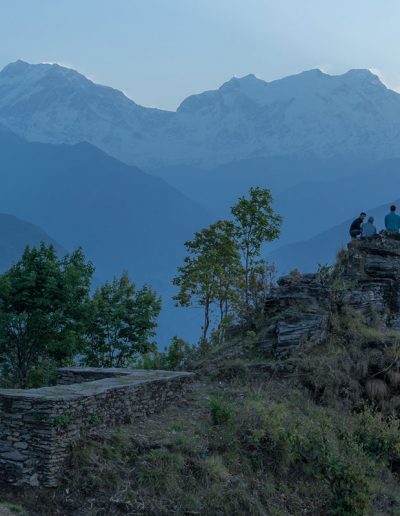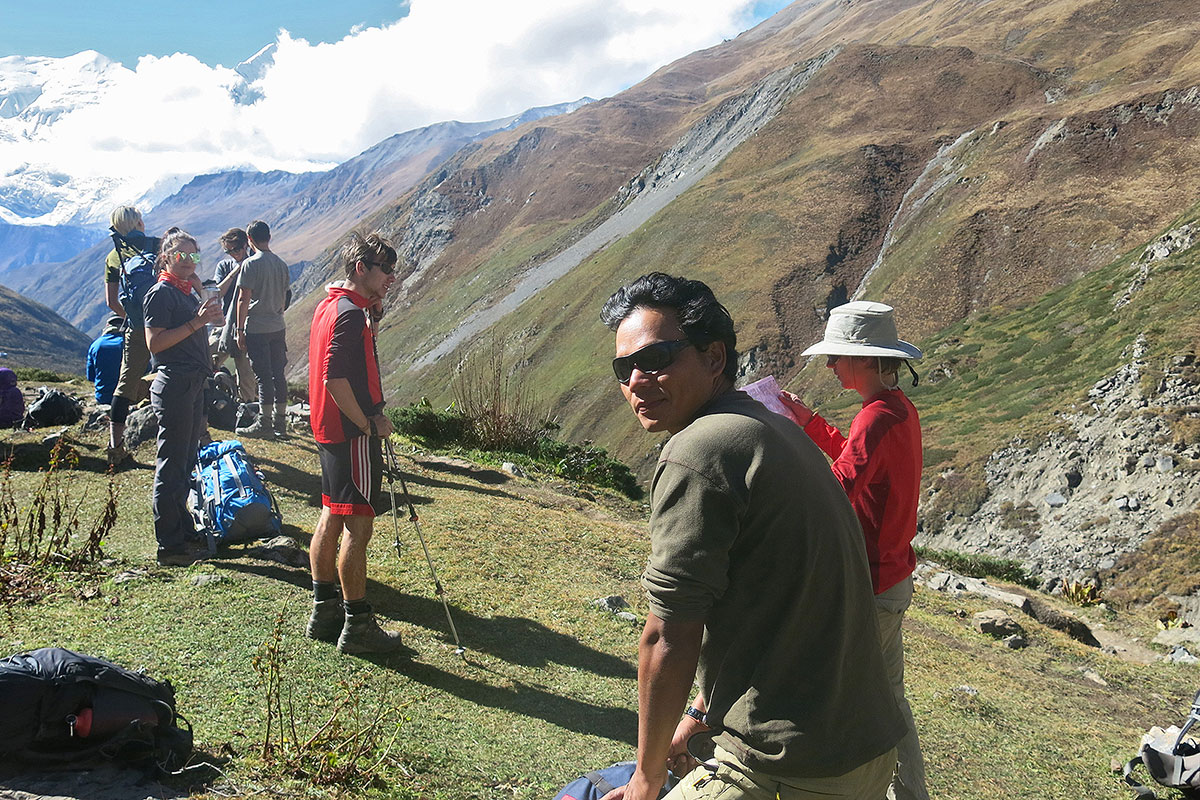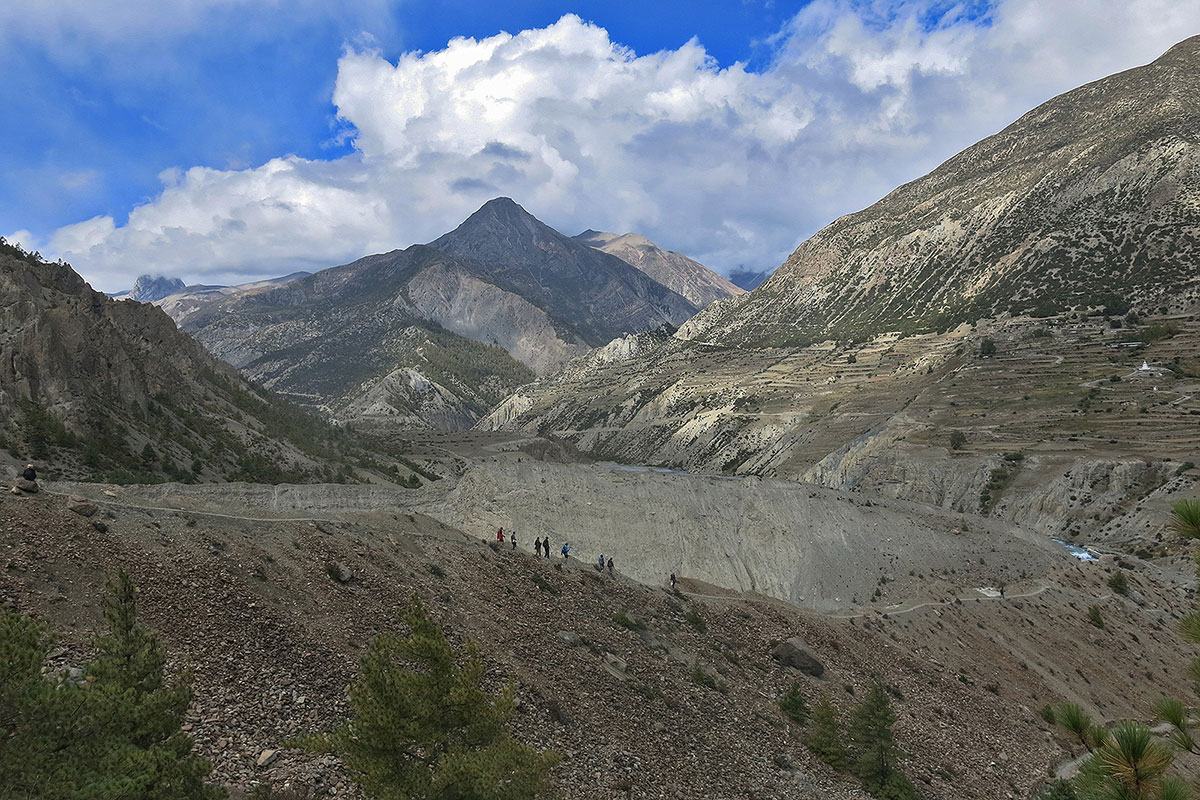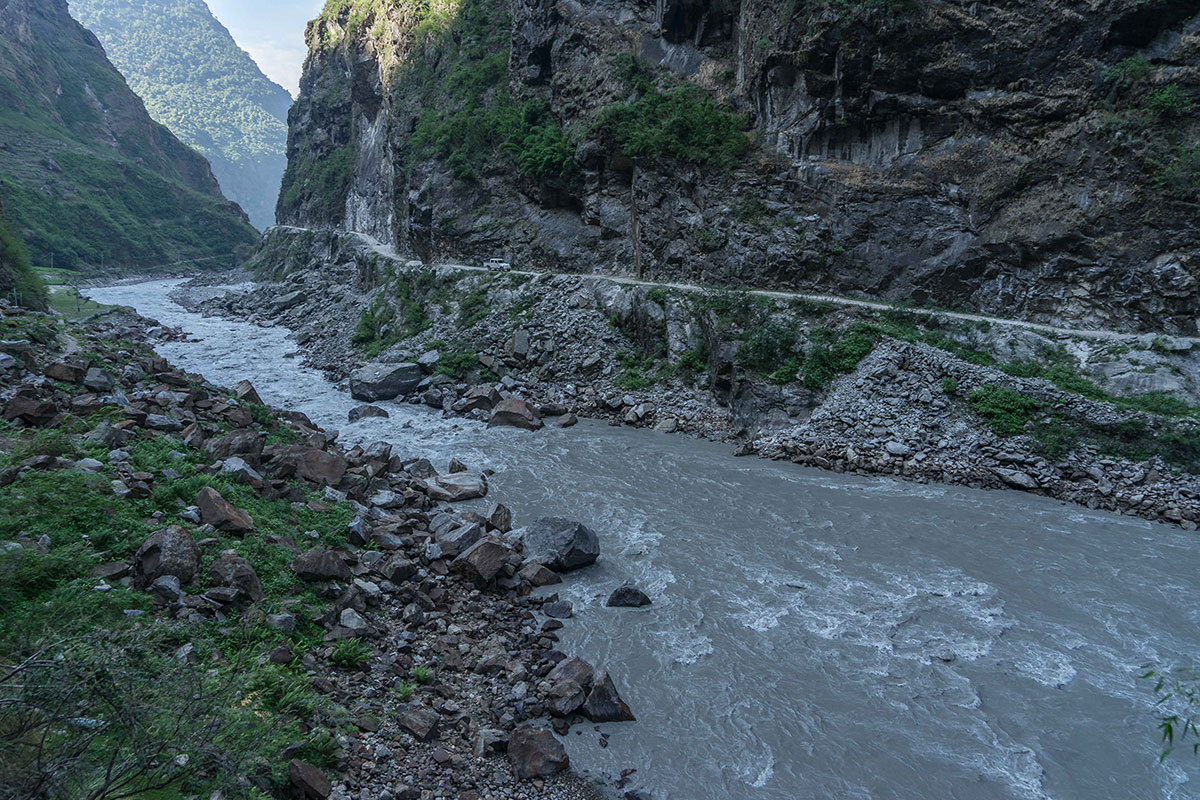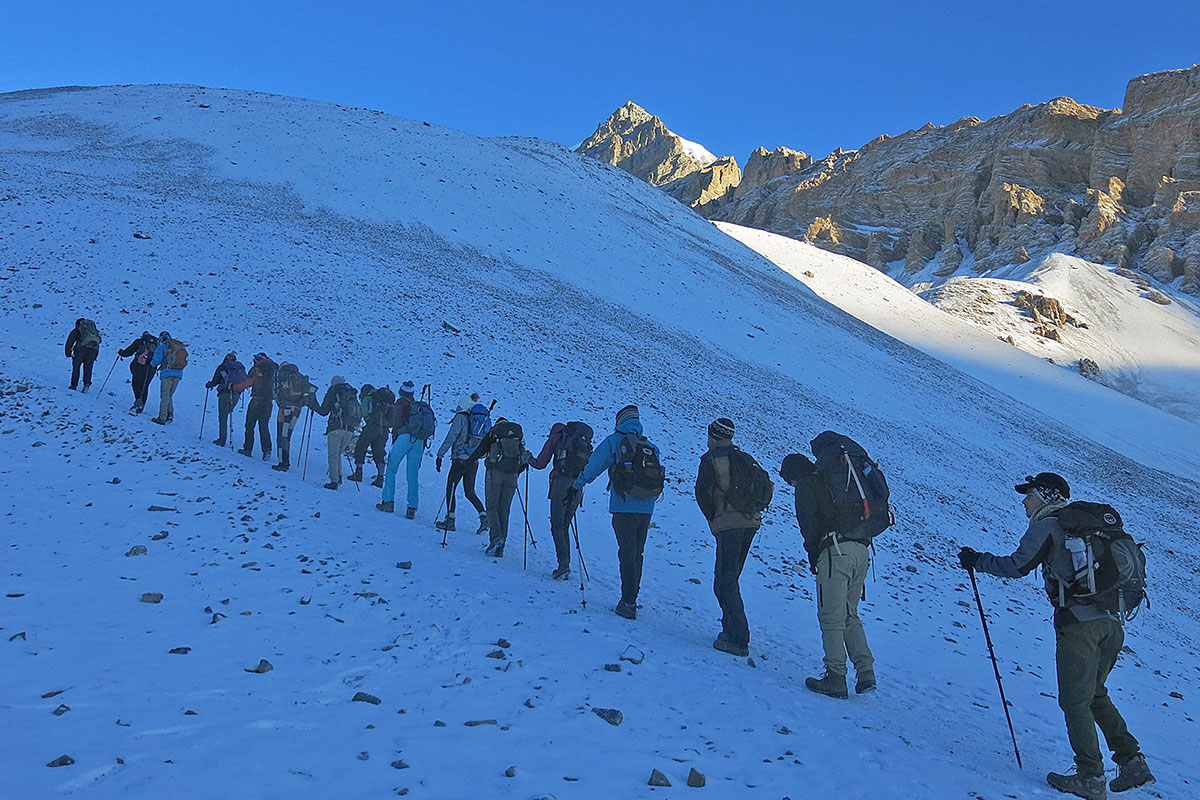Annapurna Circuit Trek
Annapurna Circuit Trek
DAYS
13
DIFFICULTY
Moderate/Strenuous
MAX ALTITUDE
ACCOMMODATION
Teahouses
DAYS
13
DIFFICULTY
Moderate/ Strenuous
MAX ALTITUDE
ACCOMMODATION
Teahouses
Trip Overview
This fully supported trek, is one of Nepal’s most iconic and diverse trekking routes, offering a journey through a stunning range of landscapes, from subtropical forests to alpine deserts and high mountain passes. Encircling the majestic Annapurna Massif, this trek takes hikers through traditional villages, alongside deep river valleys and over the Thorong La Pass at 5,416 meters, the highest point of the trek. The Annapurna Circuit is renowned for its cultural richness, with trekkers encountering a mix of Hindu and Buddhist communities, as well as awe-inspiring views of some of the world’s tallest peaks, including Annapurna and Dhaulagiri.
Day 1: Trek briefing, preparation and last-minute shopping
Day 2: Drive Kathmandu – Bargarchhap (2,164m, c.8-10 hours including stops)
Day 3: Trek Bagarchhap – Chame (2,730m, c.6 hours)
Day 4: Trek Chame – Pisang (3,186m, c.6-7 hours)
Day 5: Trek Pisang – Ngawal Via Ghyaru (3,660m, c.6-7 hours)
Day 6: Trek Ngawal – Manang (3,540m, c.4-5 hours)
Day 7: Acclimatisation day and local hike to the Milarepa Cave (4,140m, c.5 hours round trip)
Day 8: Trek Manang – Yak Kharka (4,050m, c.6 hours)
Day 9: Trek Yak Kharka – Thorong Phedi (4,510m, c.4hrs)
Day 10: Trek from Thorong Phedi – Muktinath (3,760m) via the Thorong La Pass (5,416m, c.9 hours)
Day 11: Trek Mukinath – Kagbeni (c.4 hours) and drive to Jomson (2,743m)
Day 12: Fly or drive Jomson- Pokhara
Day 13: Fly or drive Pokhara – Kathmandu
Note: The itinerary is a guide only and may be subject to change at short notice.
Day 1 (B)
Trek briefing, preparation and last-minute shopping
Overnight in hotel in Kathmandu
Day 2 (B L D)
Drive Kathmandu – Bargarchhap (2,164m, c.8-10 hours including stops)
The drive from Kathmandu to Bargarchhap is a long, scenic, yet challenging journey that covers approximately 240km and takes around 8-10 hours. The route begins with a drive through the bustling Kathmandu Valley, offering views of terraced fields and traditional villages. As you head west towards Besisahar, the gateway to the Annapurna Circuit, the road follows the Trishuli River, with lush green hills and weather dependant glimpses of the Himalayan foothills in the distance. After Besisahar, the road becomes rougher and narrower, winding through steep valleys alongside the Marsyangdi River. You’ll pass small mountain villages like Chamje and Tal, surrounded by dramatic cliffs and waterfalls. The landscape transitions from subtropical to more alpine as you approach Bargarchhap, offering views of the Annapurna and Manaslu ranges. Although, long, windy and at times, bumpy, this drive sets the stage for the trekking adventure ahead, gradually immersing you in the remote and beautiful landscapes of the Annapurna region.
Day 3 (B L D)
Trek Bagarchhap – Chame (2,730m, c.6 hours)
After yesterday’s long journey, today you get to stretch your legs. The trail ascends gradually through a mix of dense pine forests, rhododendron woods and charming villages as you walk along a dirt track. You’ll pass through Gurung villages where prayer flags flutter and Mani walls are etched with Buddhist prayers. The architecture here begins to reflect more of the Tibetan style as you move deeper into the Manang district. Today’s ascents will be moderate and there will also be some descents as you cross suspension bridges over gushing rivers.
Day 4 (B L D)
Trek Chame – Pisang (3,186m, c.6-7 hours)
Today’s trail includes steep and moderate ascents, with sections of flat paths through dense forests of pine and spruce. The Marsyangdi River will accompany you as you walk, with the trail narrowing as you approach the broad valley of Pisang. Pisang marks the entry into the upper region where the influence of Tibetan Buddhism is stronger. Monasteries and Mani walls are more common and you might hear the melodic chanting of monks. Today you should have stunning views of Annapurna II and Pisang Peak.
Day 5 (B L D)
Trek Pisang – Ngawal Via Ghyaru (3,660m, c.6-7 hours)
This day involves a demanding climb to Ghyaru, one of the most strenuous sections of the trek, followed by a traverse along the high trail to Ngawal, known for its panoramic views of Annapurna III, Annapurna IV and the Marsyangdi Valley. The villages of Ghyaru and Ngawal are rich in Tibetan culture, with ancient monasteries and traditional stone houses. The locals live a semi-nomadic lifestyle, herding yaks and cultivating barley.
Day 6 (B L D)
Trek Ngawal – Manang (3,540m, c.4-5 hours)
Today’s trail is relatively gentle, winding through juniper bushes and arid landscapes. It’s a more leisurely day with broad, open views of the surrounding mountains including Gangapurna and Annapurna III. Manang is the largest village in the region and is culturally rich with influences from both Tibetan Buddhism and the Gurung community. The village is a hub for trekkers, with many shops, bakeries and a great local museum.
Day 7 (B L D)
Acclimatisation day and local hike to the Milarepa Cave (4,140m, c.5 hours round trip)
Today is an acclimatisation day, whereby you walk high and sleep low in readiness for the Thorong La Pass crossing in a few days’ time. After breakfast you will head off to explore the sacred cave where the famous Tibetan Buddhist saint, Milarepa meditated. It is a gradual ascent to Milarepa Cave, with the trail meandering through alpine meadows with views of the high Himalayas. You may well encounter local pilgrims along the way or at the cave.
Day 8 (B L D)
Trek Manang – Yak Kharka (4,050m, c.6 hours)
Today’s trail ascends gradually, passing through high-altitude meadows and the remnants of ancient glacial valleys, with the landscape becoming more barren the higher you go. Along the way you should look out for yaks grazing in the high-altitude pastures, while enjoying the views of the surrounding peaks and glacial moraines. Yak Kharka is a grazing area where yaks and other livestock are kept. The influence of Tibetan Buddhism remains strong and you’ll see many prayer flags and Mani stones.
Day 9 (B L D)
Trek Yak Kharka – Thorong Phedi (4,510m, c.4hrs)
The trail from Yak Kharka runs alongside the Jarsnag Khola river and continues to ascend steadily, becoming increasingly rocky and barren as you approach Thorong Phedi. Thorong Phedi is a remote outpost, serving as the base camp for the Thorong La Pass. There’s little in the way of local culture here, but the camaraderie among trekkers is strong before you head over the pass tomorrow.
Day 10 (B L D)
Trek from Thorong Phedi – Muktinath (3,760m) via the Thorong La Pass (5,416m, c.9 hours)
Today is a long hard day as you’ll leave in the early hours, walking by the light of your head torch so you can cross the pass before the wind picks up and gets too strong. It is a long steep ascent to the Thorong La Pass, on a rocky trail, with potential snow or ice near the top, but you’ll stop along the way for a much-needed snack and hot drink and again at the top, for the obligatory celebratory photo at the highest point on the trek surrounded by stunning views. What goes up, must come down and from the pass its a long descent to Muktinath. Muktinath is a sacred site for both Hindus and Buddhists and the temple complex is an important pilgrimage site for both religions.
Day 11 (B L D)
Trek Mukinath – Kagbeni (c.4 hours) and drive to Jomson (2,743m)
After yesterday’s epic trek, today, your final day on the trail is both shorter and gentler. The trail descends steadily through the arid landscapes of Mustang, following the Kali Gandaki River. The path is easy but can be windy, with broad views of the Mustang region. Kagbeni is a traditional Mustang village, where Tibetan culture is strong. The village is known for its ancient monastery and as the gateway to Upper Mustang and after lunch you will have time to explore this fascinating medieval village.
Day 12
Fly or drive Jomson – Pokhara
A short 20 minute flight or a 7-8 hour drive to Pokhara.
Day 13
Drive (6-7 hours) or fly (25 mins) to Kathmandu.
Note: The itinerary is a guide only and may be subject to change at short notice.
Himalayan Quests uses a layering system where different pieces of clothing are worn together or separately to achieve optimum body temperature control. The upper body garments listed here are either synthetic or merino wool garments that retain their insulating properties when wet, or nylon or Gore-Tex layers which help prevent heat loss by cutting wind, rain, and snow.
This is a guideline only
| UPPER BODY LAYERS | ||
| Equipment | Quantity | Comments |
| T-Shirts – walking | 2 | We recommend merino wool, Capilene or other synthetic fabric as they wick away the moisture and dry quickly. No cotton. |
| T-shirt – sleeping | 1 | This can be cotton |
| Base layers (ie thermal top) | 1 | Lightweight or mid-weight long-sleeved t-shirt of merino wool, polyester, Capilene, or Polartec power dry |
| Top insulating Layers | 1 | Mid-weight fleece that can be worn over other layers |
| Fleece Vest | 1 | |
| Rain jacket | 1 | |
| Down Jacket | 1 | |
| LOWER BODY LAYERS | ||
| Equipment | Quantity | Comments |
| Underwear | Sufficient for the trek (remember you can wash them) | |
| Thermal long johns/long underwear | 1 | |
| Trekking Trousers | 2 | Lightweight quick-dry trousers (no cotton). Zip offs are good |
| Evening/sleeping trousers | 1 optional | 1 pair of lightweight tracksuit bottoms (sweat pants) or yoga style trousers for evening wear and sleeping in. No jeans. |
| Hiking Shorts | 1 | If no zip-off trousers. Below the knee for ladies |
| Rain Pants | 1 | |
| PACKS & BAGS | ||
| Equipment | Quantity | Comments |
| Day pack | 1 | Approx. 35ltrs. HQ will provide you with a duffle bag for your trekking gear |
| Sleeping bag with compression sack | 1 | Minimum 3 season |
| Sleeping bag liner | 1 | Optional |
| FOOTWEAR | ||
| Equipment | Quantity | Comments |
| Hiking boots | 1 | Must be well worn and comfortable with ankle support |
| Socks | 3 | |
| Flip flops/Camp shoes | 1 | Lightweight for evening use |
| MISCELLANEOUS ITEMS | ||
| Equipment | Quantity | Comments |
| Water bottles | 2 | One liter each, Nalgene or Sig style or a bladder if preferred |
| Water purification drops | 1 | Cheap and easy to buy in Kathmandu (Piyus) |
| Lip Balm | 1 | With SPF factor |
| Sunscreen | 1 | We recommend SPF 30 or greater |
| Mosquito repellent | 1 | |
| Personal first aid kit | 1 | To include any prescribed medications |
| Sunglasses | 1 | |
| Bandana/Buff | 1 | Useful for a variety of purposes. |
| Flashlight /head torch | 1 | Head torch is best as it leaves your hands free + extra batteries |
| Travel towel | 1 | Lightweight and compact |
| Wash kit | Travel size items for the trek & eco friendly if possible | |
| Instant Hand Sanitizer | 1 | Alcohol-based for keeping hands clean |
| Sun hat | 1 | |
| Warm hat | 1 | |
| Gloves | 1 | |
| Trekking poles | Optional | |
| Trekking snacks | Good selection available in KTM | |
| Camera | With charger &/or extra batteries | |
| Toilet paper & rubbish bag | ||
| Book/journal | ||
| Pack of cards/travel game | 1 | For evening entertainment |
| Passport photos | Always useful and a must-have if you want a local sim card | |
| Photocopies of all your important documents | ||
| A great sense of humor & a positive attitude | Essential – don’t come without it!! J | |
Your trek cost includes:
- Pre-trip advice and detailed information
- Expert trip leadership and motivated staff for the duration of the trek
- Airport transfers in Nepal (where applicable)
- 2 nights accommodation pre-trek & 1-night post-trek in Kathmandu
- 1-night accommodation pre or post-trek in Pokhara (where applicable)
- Transportation to and from trek start and finish for you and your trekking team (different budget options available)
- Basic teahouse/lodge/camping accommodation during the trek on a twin sharing basis
- During the trek all meals on a full board basis (breakfast, lunch, and dinner) to include tea/coffee during the meals, but excluding any drinks outside of the meal times
- All permits, conservation area, and restricted area fees
- Porters
- Insurance and equipment for Nepali staff
- Rescue assistance
- Group medical kit
Your trek cost does NOT include:
- International flights to and from Kathmandu, Nepal
- Visa for Nepal
- Travel insurance (insurance to include evacuation is mandatory. Please make sure you are covered to the correct altitude)
- Personal expenses such as fizzy drinks, chocolate, gifts, snacks, hot showers during the trek, etc.
- Meals unless specified
- Sightseeing
- Gratuities
- Excess baggage on internal flights
- Charges incurred as a result of delays beyond the control of Himalayan Quests
Day 1: Trek briefing, preparation and last-minute shopping
Day 2: Drive Kathmandu – Bargarchhap (2,164m, c.8-10 hours including stops)
Day 3: Trek Bagarchhap – Chame (2,730m, c.6 hours)
Day 4: Trek Chame – Pisang (3,186m, c.6-7 hours)
Day 5: Trek Pisang – Ngawal Via Ghyaru (3,660m, c.6-7 hours)
Day 6: Trek Ngawal – Manang (3,540m, c.4-5 hours)
Day 7: Acclimatisation day and local hike to the Milarepa Cave (4,140m, c.5 hours round trip)
Day 8: Trek Manang – Yak Kharka (4,050m, c.6 hours)
Day 9: Trek Yak Kharka – Thorong Phedi (4,510m, c.4hrs)
Day 10: Trek from Thorong Phedi – Muktinath (3,760m) via the Thorong La Pass (5,416m, c.9 hours)
Day 11: Trek Mukinath – Kagbeni (c.4 hours) and drive to Jomson (2,743m)
Day 12: Fly or drive Jomson- Pokhara
Day 13: Fly or drive Pokhara – Kathmandu
Note: The itinerary is a guide only and may be subject to change at short notice.
Day 1 (B)
Trek briefing, preparation and last-minute shopping
Overnight in hotel in Kathmandu
Day 2 (B L D)
Drive Kathmandu – Bargarchhap (2,164m, c.8-10 hours including stops)
The drive from Kathmandu to Bargarchhap is a long, scenic, yet challenging journey that covers approximately 240km and takes around 8-10 hours. The route begins with a drive through the bustling Kathmandu Valley, offering views of terraced fields and traditional villages. As you head west towards Besisahar, the gateway to the Annapurna Circuit, the road follows the Trishuli River, with lush green hills and weather dependant glimpses of the Himalayan foothills in the distance. After Besisahar, the road becomes rougher and narrower, winding through steep valleys alongside the Marsyangdi River. You’ll pass small mountain villages like Chamje and Tal, surrounded by dramatic cliffs and waterfalls. The landscape transitions from subtropical to more alpine as you approach Bargarchhap, offering views of the Annapurna and Manaslu ranges. Although, long, windy and at times, bumpy, this drive sets the stage for the trekking adventure ahead, gradually immersing you in the remote and beautiful landscapes of the Annapurna region.
Day 3 (B L D)
Trek Bagarchhap – Chame (2,730m, c.6 hours)
After yesterday’s long journey, today you get to stretch your legs. The trail ascends gradually through a mix of dense pine forests, rhododendron woods and charming villages as you walk along a dirt track. You’ll pass through Gurung villages where prayer flags flutter and Mani walls are etched with Buddhist prayers. The architecture here begins to reflect more of the Tibetan style as you move deeper into the Manang district. Today’s ascents will be moderate and there will also be some descents as you cross suspension bridges over gushing rivers.
Day 4 (B L D)
Trek Chame – Pisang (3,186m, c.6-7 hours)
Today’s trail includes steep and moderate ascents, with sections of flat paths through dense forests of pine and spruce. The Marsyangdi River will accompany you as you walk, with the trail narrowing as you approach the broad valley of Pisang. Pisang marks the entry into the upper region where the influence of Tibetan Buddhism is stronger. Monasteries and Mani walls are more common and you might hear the melodic chanting of monks. Today you should have stunning views of Annapurna II and Pisang Peak.
Day 5 (B L D)
Trek Pisang – Ngawal Via Ghyaru (3,660m, c.6-7 hours)
This day involves a demanding climb to Ghyaru, one of the most strenuous sections of the trek, followed by a traverse along the high trail to Ngawal, known for its panoramic views of Annapurna III, Annapurna IV and the Marsyangdi Valley. The villages of Ghyaru and Ngawal are rich in Tibetan culture, with ancient monasteries and traditional stone houses. The locals live a semi-nomadic lifestyle, herding yaks and cultivating barley.
Day 6 (B L D)
Trek Ngawal – Manang (3,540m, c.4-5 hours)
Today’s trail is relatively gentle, winding through juniper bushes and arid landscapes. It’s a more leisurely day with broad, open views of the surrounding mountains including Gangapurna and Annapurna III. Manang is the largest village in the region and is culturally rich with influences from both Tibetan Buddhism and the Gurung community. The village is a hub for trekkers, with many shops, bakeries and a great local museum.
Day 7 (B L D)
Acclimatisation day and local hike to the Milarepa Cave (4,140m, c.5 hours round trip)
Today is an acclimatisation day, whereby you walk high and sleep low in readiness for the Thorong La Pass crossing in a few days’ time. After breakfast you will head off to explore the sacred cave where the famous Tibetan Buddhist saint, Milarepa meditated. It is a gradual ascent to Milarepa Cave, with the trail meandering through alpine meadows with views of the high Himalayas. You may well encounter local pilgrims along the way or at the cave.
Day 8 (B L D)
Trek Manang – Yak Kharka (4,050m, c.6 hours)
Today’s trail ascends gradually, passing through high-altitude meadows and the remnants of ancient glacial valleys, with the landscape becoming more barren the higher you go. Along the way you should look out for yaks grazing in the high-altitude pastures, while enjoying the views of the surrounding peaks and glacial moraines. Yak Kharka is a grazing area where yaks and other livestock are kept. The influence of Tibetan Buddhism remains strong and you’ll see many prayer flags and Mani stones.
Day 9 (B L D)
Trek Yak Kharka – Thorong Phedi (4,510m, c.4hrs)
The trail from Yak Kharka runs alongside the Jarsnag Khola river and continues to ascend steadily, becoming increasingly rocky and barren as you approach Thorong Phedi. Thorong Phedi is a remote outpost, serving as the base camp for the Thorong La Pass. There’s little in the way of local culture here, but the camaraderie among trekkers is strong before you head over the pass tomorrow.
Day 10 (B L D)
Trek from Thorong Phedi – Muktinath (3,760m) via the Thorong La Pass (5,416m, c.9 hours)
Today is a long hard day as you’ll leave in the early hours, walking by the light of your head torch so you can cross the pass before the wind picks up and gets too strong. It is a long steep ascent to the Thorong La Pass, on a rocky trail, with potential snow or ice near the top, but you’ll stop along the way for a much-needed snack and hot drink and again at the top, for the obligatory celebratory photo at the highest point on the trek surrounded by stunning views. What goes up, must come down and from the pass its a long descent to Muktinath. Muktinath is a sacred site for both Hindus and Buddhists and the temple complex is an important pilgrimage site for both religions.
Day 11 (B L D)
Trek Mukinath – Kagbeni (c.4 hours) and drive to Jomson (2,743m)
After yesterday’s epic trek, today, your final day on the trail is both shorter and gentler. The trail descends steadily through the arid landscapes of Mustang, following the Kali Gandaki River. The path is easy but can be windy, with broad views of the Mustang region. Kagbeni is a traditional Mustang village, where Tibetan culture is strong. The village is known for its ancient monastery and as the gateway to Upper Mustang and after lunch you will have time to explore this fascinating medieval village.
Day 12
Fly or drive Jomson – Pokhara
A short 20 minute flight or a 7-8 hour drive to Pokhara.
Day 13
Drive (6-7 hours) or fly (25 mins) to Kathmandu.
Note: The itinerary is a guide only and may be subject to change at short notice.
Your trek cost includes:
- Pre-trip advice and detailed information
- Expert trip leadership and motivated staff for the duration of the trek
- Airport transfers in Nepal (where applicable)
- 2 nights accommodation pre-trek & 1-night post-trek in Kathmandu
- 1-night accommodation pre or post-trek in Pokhara (where applicable)
- Transportation to and from trek start and finish for you and your trekking team (different budget options available)
- Basic teahouse/lodge/camping accommodation during the trek on a twin sharing basis
- During the trek all meals on a full board basis (breakfast, lunch, and dinner) to include tea/coffee during the meals, but excluding any drinks outside of the meal times
- All permits, conservation area, and restricted area fees
- Porters
- Insurance and equipment for Nepali staff
- Rescue assistance
- Group medical kit
Your trek cost does NOT include:
- International flights to and from Kathmandu, Nepal
- Visa for Nepal
- Travel insurance (insurance to include evacuation is mandatory. Please make sure you are covered to the correct altitude)
- Personal expenses such as fizzy drinks, chocolate, gifts, snacks, hot showers during the trek, etc.
- Meals unless specified
- Sightseeing
- Gratuities
- Excess baggage on internal flights
- Charges incurred as a result of delays beyond the control of Himalayan Quests
Trekking Gear List
Himalayan Quests uses a layering system where different pieces of clothing are worn together or separately to achieve optimum body temperature control. The upper body garments listed here are either synthetic or merino wool garments which retain their insulating properties when wet, or nylon or Gore-Tex layers which help prevent heat loss by cutting wind, rain and snow.
THIS IS A GUIDELINE ONLY
UPPER BODY LAYERS
- T Shirts – walking 2 Merino wool, Capilene or other synthetic, wicking fabric. No cotton
- T-shirt – sleeping 1 Can be cotton
- Base layers 1 Light weight or mid weight thermal long sleeved t-shirt
- Top insulating Layers 1 Mid weight fleece that can be worn over other layers
- Fleece Vest 1
- Rain jacket 1
- Down jacket 1
LOWER BODY LAYERS
- Underwear Sufficient for trek (remember you can wash them)
- Thermal long underwear 1
- Trekking Trousers 2 Lightweight quick dry trousers (no cotton). Zip-offs are good
- Hiking Shorts 1 If no zip-off trousers. Below the knee for ladies
- Rain Pants 1
PACKS & BAGS
- Day pack 1 35ltrs. HQ will provide you with a duffle bag for your trekking gear
- Sleeping bag & compression sack 1 Minimum 3 season
FOOTWEAR
- Hiking boots 1 Must be well worn and comfortable with ankle support
- Socks 3 or 4
- Flip flops/Camp shoes 1 Lightweight for evening use
MISCELLANEOUS ITEMS
- Water bottles 2 One litre each, Nalgene or Sig style or a bladder if preferred
- Water purification drops Cheap and easy to buy in Kathmandu (Piyus)
- Sunscreen We recommend SPF 30 or greater
- Lip Balm With SPF factor
- Personal first aid kit To include any prescribed medications
- Sunglasses
- Bandana/Buff
- Flash light /head torch Head torch is best as it leaves your hands free + extra batteries
- Travel towel Lightweight and compact
- Wash kit Travel size items for the trek & eco friendly if possible
- Hand Sanitizer Alcohol-based for keeping hands clean
- Sun hat
- Warm hat
- Gloves
- Trekking poles Optional, but advised if you have dodgy knees
- Toilet paper & rubbish bag
- Trekking snacks Good selection available in KTM
- Camera With charger &/or extra batteries
- Book/journal
- Pack of cards/travel game For evening entertainment
- Mosquito repellent
- Passport photos Always useful and a must have if you want a local sim card
- Photocopies of all your important documents
- A great sense of humour & positive attitude Essential – don’t come without it!! J
Much of the above equipment can be bought cheaply in Kathmandu. You do not need to spend a fortune on gear.
Similar Trips

Three Passes Trek
18 Days
The pathways you will tread will not only take you to the foot of the world’s highest mountain but up and over three 5,000m+ passes – Kongma La Pass (5,535m), Cho La Pass (5420m/) and Renjo La Pass (5,340m) and also to Gokyo and its surrounding lakes.
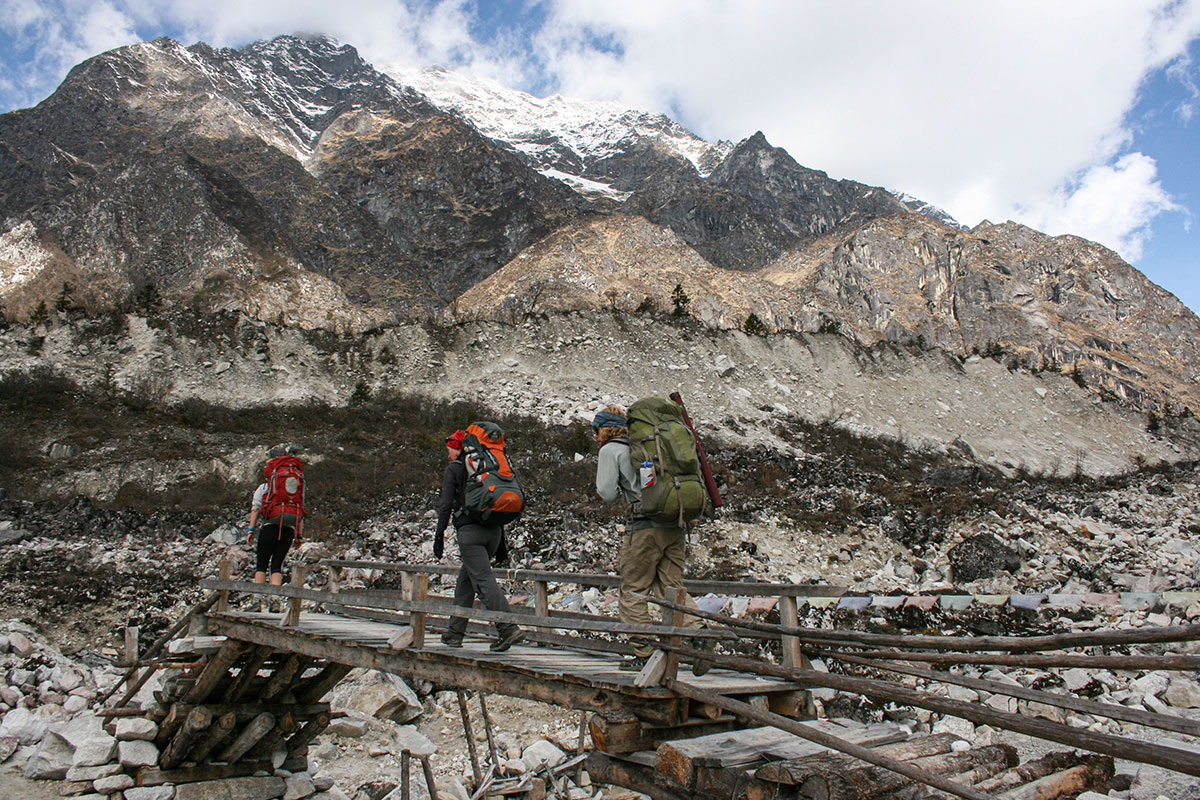
Tsum Valley Manaslu Circuit Trek
22 Days
Just as diverse as the ethnic population, so too the scenery varies from the lush, low elevation valleys growing rice and bananas, inhabited predominantly by the Hindu ethnic groups of Indo-Aryan origin, through rhododendron and bamboo forests, where you begin to encounter communities of Tibeto-Burmese origin who practice Hinduism, Buddhism or a mixture of both.
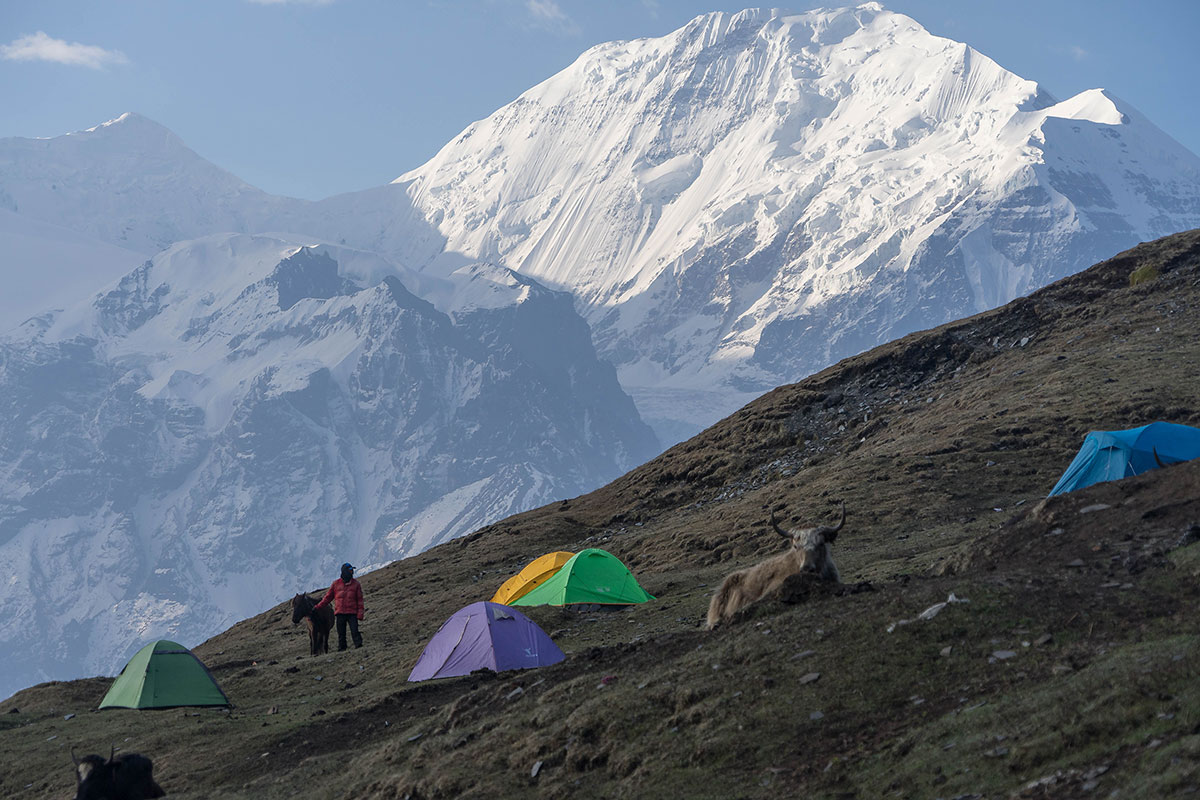
Nar Phu Annapurna Circuit Trek
17 Days
Trekking through remote villages steeped in Tibetan heritage and still following their ancient traditions of yak herding, harvesting wild herbs for medicinal purposes, and trading across the Tibetan border it will be like stepping back in time.

THREE PASSES TREK
18 Days
The pathways you will tread will not only take you to the foot of the world’s highest mountain but up and over three 5,000m+ passes – Kongma La Pass (5,535m), Cho La Pass (5420m/) and Renjo La Pass (5,340m) and also to Gokyo and its surrounding lakes.

TSUM VALLEY MANASLU CIRCUIT TREK
22 Days
Just as diverse as the ethnic population, so too the scenery varies from the lush, low elevation valleys growing rice and bananas, inhabited predominantly by the Hindu ethnic groups of Indo-Aryan origin, through rhododendron and bamboo forests, where you begin to encounter communities of Tibeto-Burmese origin who practice Hinduism, Buddhism or a mixture of both.

NAR PHU ANNAPURNA CIRCUIT TREK
17 Days
Trekking through remote villages steeped in Tibetan heritage and still following their ancient traditions of yak herding, harvesting wild herbs for medicinal purposes, and trading across the Tibetan border it will be like stepping back in time.
CONTACT US
Let us help you plan the trip of your dreams
Address
GPO Box: 8974 CPC 437
Kathmandu, Nepal.
Nepal Govt. Registration
11881/424 1134/066
Phone
Our Team
Diaries
Featured Trips
Bespoke For You
CONTACT US
Let us help you plan the trip of your dreams
Address
GPO Box: 8974 CPC 437
Kathmandu, Nepal.
Nepal Govt. Registration
11881/424 1134/066
info@himalayanquests.com
Phone
+977 9849 141067

